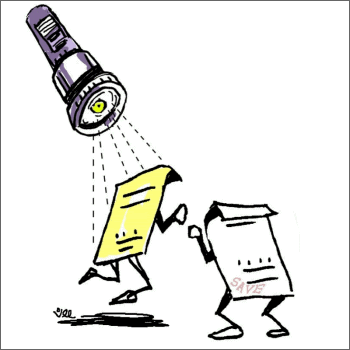Saving the Original
Manipulations of digital images should always be done on a copy of the raw image data. The original must be retained.

- The raw image data file is an investigator’s safety net.
- Processed images can be compared to unprocessed images to ensure that important data was not lost from, or inadvertent artifacts added to, the processed images.
- A copy of the unprocessed image is an extremely important protection for an investigator in the event that an accusation of scientific misconduct is made.
- Given the trend towards making online publications the journal of record, as well as the use of supplemental data appendices, it is possible that an investigator’s image data will be available for further analysis by others for many years after publication. Proper archiving of raw data will continue to protect the investigator in the event that his/her analysis or manipulation of the data is questioned at some future date.
- A growing number of journals have indicated in their instructions to authors that the raw data may be required from the authors in the event that there are questions about the image processing or data interpretation.
- Keeping a copy of the raw image data file is also a user’s greatest protection against an inadvertent mistake in image processing.
- The Microscopy Society of America has recommended that all image data be written to read-only media, such as CD-R or DVD-R, as soon after the experiment as is possible.
- Because of the possibility of bad media, creating a second copy of a disc is often advisable. Discs should be properly labeled and stored; kept out of extremes of heat or cold, and should not be exposed to direct sunlight.
- The raw image data may initially be created in a vendor’s proprietary file format.
- In some cases the proprietary file format may include metadata that describes the image acquisition conditions.
- Do not discard the files containing the metadata, it is vital if the experiment is to be repeated under similar conditions.
- Some journals require that data about the acquisition conditions be provided for online supplementary materials.
- When converting image data from a proprietary format, users should save their image data as TIFF (tagged image file format) files.
- The TIFF file format is recommended by the Microscopy Society of America. TIFF is a loss-less file format that supports a wide range of bit-depths.
- Do not use the JPEG file format. JPEG uses a lossy form of compression and is inappropriate for most scientific images (see guideline #10).
- In certain industries the retention of the raw image data file is mandatory. Examples:
- Any corporation of individual who ’s research falls under the US Food and Drug Administration’s 21 CFR part 11 regulations on electronic records and electronic signatures.
- Forensic scientists – under the rules for evidence
- Clinical/Diagnostic laboratories – liability issues and HIPAA regulations (Health Insurance Portability and Accountability Act of 1996)
|

